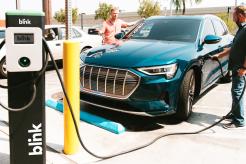The minute you think electric vehicle (EV) charging technology has reached the pinnacle of its potential, EV researchers come up with yet another application that can advance the quality of life around the world. While vehicle-to-grid (V2G) technology is a marvel in its own right, V2X EV charging technology takes the concept of bidirectional charging to a whole new level.

Image via Wikimedia Commons
Following close on the heels of leading-edge V2G technology, V2X technology uses the potential that EV batteries have to power homes, independent local grids, and even farms, expanding on the bidirectional charging technology introduced by V2G applications. Learn the ways V2X charging differs from V2G – and how it can make a difference in people’s lives worldwide.
What Is V2X Charging?
Think back to your high school algebra class, where “x” meant a variable quantity. In the EV charging space, “X” stands for “everything” – a variable number of things capable of receiving an electrical charge to power them.
V2X charging, then, is vehicle-to-everything charging – “transferring the electricity stored in electric vehicle batteries to the grid, building, houses, and other energy-consuming destinations,” as a Driivz post put it. In other words, this promising new technology’s only limitation is the ability of a thing to store or use electricity to power itself or other devices.
Like V2G technology, V2X technology depends on bidirectional charging from the EV charger to the vehicle and back into the charging station. Also, the vehicle’s battery must be able to transfer energy into another receptacle.
How Does V2X Charging Go Beyond Feeding Energy into the Grid?

Image via Freepik
However, unlike V2G, devices and systems receiving electricity from an EV can encompass much more than the grid. Here are some other applications of V2X technology besides V2G, all falling under the umbrella of V2X EV charging technology.
- Vehicle-to-building (V2B) charging: V2B charging channels electricity from EVs parked near or inside large offices or other commercial buildings to the buildings themselves. It gives buildings the ability to weather power outages and decrease the load during peak usage hours yet leaves the EVs parked there with sufficient charge to get where they need to go at the day’s end.
- Vehicle-to-home (V2H) charging: V2H technology funnels energy from a homeowner’s EV back into the home’s electrical power to keep it running during power outages. V2H charging can be a lifesaver for homeowners during storms or other emergencies, keeping medical equipment and home refrigeration running even in the storm’s aftermath.
- Vehicle-to-vehicle (V2V) charging: V2V charging allows EV owners to use their cars to power other electric vehicles, including trucks, golf carts, e-bikes, and electric scooters.
- Vehicle-to-load (V2L) charging: V2L technology utilizes a DC-to-AC inverter to feed an EV battery’s power into AC power outlets. That allows the EV battery to serve as an alternative power source for electrical appliances, tools, and other devices. Hyundai has already enabled one car in its 2024 EV lineup, the Kona Electric, with V2L capability. Other carmakers will likely follow Hyundai’s lead to remain competitive.
- Vehicle-to-farm (V2F) charging: V2F charging uses V2H, V2B, and V2L applications to power farm equipment, keep the barn lights on during power outages, and pump water from the farm wells into the barn so that farm animals can remain hydrated.

Image courtesy of Dietmar Rabich / Wikimedia Commons / “Dülmen, Kirchspiel, Daldrup, BMW i3 — 2019 — 7442” / CC BY-SA 4.0
What Do I Need to Equip My EV for V2X Charging?
First, before buying an EV, check to see if it is V2G enabled. If you plan to use your vehicle for V2L applications that connect to AC power outlets, you’ll also need a DC-to-AC inverter.
You’ll also need a bidirectional charger to make sure electricity can flow both ways – from and into your vehicle. To ensure that your charger and vehicle can communicate with each other, you’ll need a V2G-compliant link that follows the ISO 15118 and OCPP 2.0.1 protocols.
To ensure that power delivery both from and to your vehicle occurs, you’ll also need a V2G-supported smart charging control system. A smart charging system balances the grid’s (or the device you’re feeding energy to) and your vehicle’s needs, allowing you to take advantage of prices at off-peak hours while ensuring safety on both ends and optimum battery life for your vehicle.
How Could V2X Charging Impact Commercial, Government, and Non-Profit Institutions?

Image via Freepik
Imagine a future in which power outages would have little impact on the speed of doing business around the world. With V2X capabilities and a primarily electric fleet, companies and other institutions could use some of their fleet vehicles’ power to serve as a backup in case of an outage, allowing the organization’s electronic devices to function normally, even during severe storms.
When combined with electric road systems – a new technology that allows EVs to charge as they drive to their destinations – V2X charging enables the company’s fleet vehicles to arrive back at their home garage fully charged and ready to use as alternative power sources when the grid goes down. Some V2X solutions designed specifically for EV fleets, such as one by the French startup Youree, enable fleet managers to monitor their vehicles’ battery health, optimize charging times, and analyze their charging expenses.
If an organization doesn’t use fleet vehicles, V2X technology could funnel electricity from employee and guest cars’ EV batteries in an emergency or during peak usage time, provided the owners give permission. With V2X’s smart charging capability, the system could also reimburse car owners for using their batteries, making it more likely for EV owners to participate in helping provide power to buildings they work or do business in.
These applications, of course, are only the tip of the iceberg. The potential V2X charging technology offers is great – and with every development comes a leap forward in the move toward greater electrification.
Discover More Emerging Technologies at the Next EV Charging Summit & Expo
V2X EV charging technology is only one of the many breakthroughs the EV Charging Summit’s presenters bring to each information-packed session. In addition to emerging technologies, our panel of experts discusses how to obtain funding for EV businesses, how to get an EV charging company off the ground, new government regulations and incentives, and the latest news in the EV charging space. You’ll also network with some of the finest minds in the EV charging industry, adding to the knowledge you’ll gain during our sessions.
So, don’t miss out on our next event! Register for your seat at the table today!






